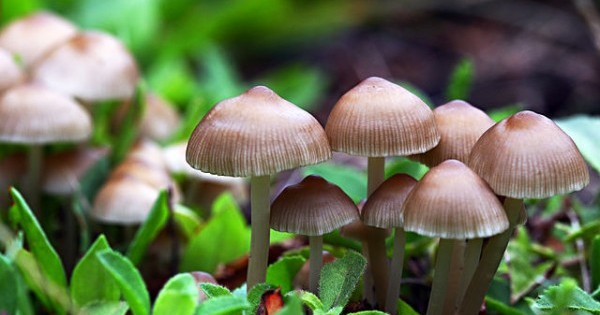
Consider the mushroom. Consider, in particular, these white button mushrooms lying on my blue plastic cutting board beside minced shallots and a stick of butter. This common, commercially grown (and naturally growing) fungus, Agaricus bisporus, belongs to the kingdom of fungi, equal in status to the animal kingdom and the plant kingdom. Before genomics revealed true evolutionary relationships, fungi were considered first cousin to plants. The new Tree of Life puts them closer to animals. And, like us, they can’t synthesize sugars out of sunlight and must eat organic plant matter, such as dead wood and dried autumn leaves.
Unlike us though, fungi grow toward their food. When they reach lunch, they excrete an enzyme that breaks it down outside their body. Only then do they ingest it. Digestion before ingestion. It’s likely that deadly mushrooms such as the death-dealing Death Cap (Amanita phalloides) kills by doing its everyday digesting on the liver of its victim. So notes Michael Pollan in The Omnivore’s Dilemma.
Fungi comprise threadlike filaments called hyphae (HI-fee). The hyphae together comprise the fungal body, the mycelium. It’s the hyphae that grow (underground) toward food, and the hyphae of some fungi can grow a half mile in one day. One humongous fungus, a honey mushroom (Armillaria ostoyae) that lives in eastern Oregon, covers 2,200 acres. One of the world’s largest organisms, it weighs some 675 tons and is more than 2,000 years old.
There are 100,000 identified species of fungi, with about a thousand new ones coming into ken each year. Fungi serve other life forms: if it weren’t for herds of fungi feeding, when trees died, the dead trunks and branches would just stack up.
And think of the leaves. In wooded areas, how many fall leaves fall? About a million per acre, that’s how many. Without fungi feeding on dead leaves, we would have a leaf problem. Fungi that eat dead plants are called saprophytes, and these include my white button mushrooms (also portobellos, shiitakes, truffles).
Another sort, the mycorrhizal fungi, cohabits with living roots. The fungus breaks down minerals and large organic molecules for the plant, and the plant provides simple sugars to the fungus. As Steven L. Stephenson (The Kingdom Fungi) writes, most plants depend on this relationship to thrive or even survive.
But fungus has a down side. Athlete’s foot, vaginal yeast infections, ringworm, Dutch Elm disease, bread mold. All are fungi, feeding, feeding. But then again, baker’s yeast is a fungus. Thanks to Saccharomyces cerevisiae, bread rises, beer ferments. And thanks to Penicillium chrysogenum, we got the first antibiotic. And thanks to magic mushrooms (Panaeolus cubensis), well, never mind.
Back to my white button mushrooms. The mushroom is the sexual part, the spore-baring, spore-spewing fruiting body. The mycelium pushes up mushrooms, which have gills under their caps, which carry and flip away spores, several hundred thousand per minute.
I’m no mycophile. I have no intention of going out into the cold woods hunting for some mushroom that might eat me if I try eating it. Instead I will stay in my kitchen. I will fry my white button fruiting body of fungus in shallots and a fat pat of butter.

